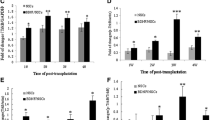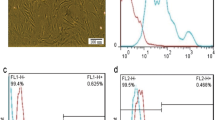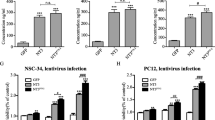Abstract
Traumatic brain injury (TBI) induces cognitive impairments, motor and behavioral deficits. Previous evidences have suggested that neural stem cell (NSC) transplantation could facilitate functional recovery from brain insults, but their underlying mechanisms remains to be elucidated. Here, we established TBI model by an electromagnetic-controlled cortical impact device in the rats. Then, 5 μl NSCs (5.0 × 105/μl), derived from green fluorescent protein (GFP) transgenic mouse, was transplanted into the traumatic brain regions of rats at 24 h after injury. After differentiation of the NSCs was determined using immunohistochemistry, neurological severity scores (NSS) and rotarod test were conducted to detect the neurological behavior. Western blot and RT-PCR as well as ELASA were used to evaluate the expression of synaptophysin and brain-derived neurotrophic factor (BDNF). In order to elucidate the role of BDNF on the neural recovery after NSC transplantation, BDNF knockdown in NSC was performed and transplanted into the rats with TBI, and potential mechanism for BDNF knockdown in the NSC was analyzed using microassay analysis. Meanwhile, BDNF antibody blockade was conducted to further confirm the effect of BDNF on neural activity. As a result, an increasing neurological function improvement was seen in NSC transplanted rats, which was associated with the upregulation of synaptophysin and BDNF expression. Moreover, transplantation of BDNF knockdown NSCs and BDNF antibody block reduced not only the level of synaptophysin but also exacerbated neurological function deficits. Microassay analysis showed that 14 genes such as Wnt and Gsk3-β were downregulated after BDNF knockdown. The present data therefore showed that BDNF-mediated neuroplasticity underlie the mechanism of NSC transplantation for the treatment of TBI in adult rats.











Similar content being viewed by others
References
Tashlykov V, Katz Y, Gazit V, Zohar O, Schreiber S, Pick CG (2007) Apoptotic changes in the cortex and hippocampus following minimal brain trauma in mice. Brain Res 1130:197–205
Shin MS, Park HK, Kim TW, Ji ES, Lee JM, Choi HS, Kim MY, Kim YP (2016) Neuroprotective effects of bone marrow stromal cell transplantation in combination with treadmill exercise following traumatic brain injury. Int Neurourol J 20(Suppl 1):S49–S56
Chen J, Qi JG, Zhang W, Zhou X, Wang TH (2007) Acupuncture induced changes in the expression of NGF, BDNF and NT-3 in L6 dorsal root ganglion after removal of adjacent ganglia in cat. Neurosci Res 59:399–405
Khaksari M, Soltani Z, Shahrokhi N, Moshtaghi G, Asadikaram G (2011) The role of estrogen and progesterone, administered alone and in combination, in modulating cytokine concentration following traumatic brain injury. J Physiol 89(1):31–40
Solomon D, Kim B, Scultetus A et al (2011) The effect of rFVIIa on pro- and anti-inflamatory cytokines in serum and cerebrospinal fluid in a swine model of traumatic brain injury. Cytokine 54(1):20–23
Maller JJ (2014) Neuroplasticity in normal and brain injured patients: potential relevance of ear wiggling locus of control and cortical projections. Med Hypotheses 83(6):838–843
Furman JL, Sompol P, Kraner SD, Pleiss MM, Putman EJ, Dunkerson J, Mohmmad Abdul H, Roberts KN et al (2016) Blockade of astrocytic calcineurin/NFAT signaling helps to normalize hippocampal synaptic function and plasticity in a rat model of traumatic brain injury. J Neurosci 36(5):1502–1515
Eriksson PS, Perfilieva E, Bjork ET et al (1998) Neurogenesis in the adult human hippocampus. Nat Med 4(11):1313–1317
Palmer TD, Takahashi J, Gage FH (1997) The adult rat hippocampus contains primordial neural stem cells. Mol Cell Neurosci 8:389–404
Pincus DW, Goodman RR, Fraser RA, Goldman SA (1998) Neural stem and progenitor cells: a strategy for gene theropy and brain repair. Neurosurgery 42(4):858–868
Reynolds BA, Weiss S (1992) Generation of neurons and astrocytes from isolated cells of the adult mammalian central nervous system. Science 255:1707–1710
Wang TT, Jing AH, Luo XY et al (2006) Neural stem cells: isolation and differentiation into cholinergic neurons. Neuroreport 17(13):1433–1436
Wei P, Liu J, Zhou HL et al (2007) Effects of engrafted neural stem cells derived from GFP transgenic mice in Parkinson’s disease rats. Neurosci Lett 419:49–54
Chaturvedi RK, Shukla S, Seth K, Agrawal AK (2008) Zuckerkandl’s organ improves long-term survival and function of neural stem cell derived dopaminergic neurons in parkinsonian rats. Exp Neurol 210(2):608–623
Zhou Z, Chen H, Zhang K (2003) Protective effect of nerve growth factor on neurons after traumatic brain injury. Basic Clinic Physiol Pharmacol 14(3):217–224
Cheng X, Jin G, Zhang X, Tian M, Zou L (2011) Stage-dependent STAT3 activation is involved in the differentiation of rat hippocampus neural stem cells. Neurosci Lett 493(1–2):18–23
Li XL, Zhang W, Zhou X, Wang TH (2007) Temporal changes in the expression of some neurotrophins in spinal cord transected adult rats. Neuropeptides 41(3):135–143
Qin DX, Zou XL, Luo W et al (2006) Expression of some neurotrophins in the spinal motoneurons after cord hemisection in adult rats. Neurosci Lett 410(3):222–227
Zhang HT, Gao ZY, Chen YZ, Wang TH (2008) Temporal changes in the level of neurotrophins in the spinal cord and associated precentral gyrus following spinal hemisection in adult Rhesus monkeys. J Chemical Neuroanatomy 36(3–4):138–143
Zhang HT, Li LY, Zou XL et al (2007) The immunohistochemical distribution of NGF, BDNF, NT-3, NT-4 in the brains of adult Rhesus monkeys. J Histochem Cytochem 55(1):1–19
Feeney DM, Boyeson MG, Linn RT, Murray HM, Dail WG (1981) Responses to cortical injury: methodology and local effects of contusions in the rat. Brain Res 211:67–77
Martinez SA, Rubio FJ, Navarro B, Bueno C, Villa A (2001) Human neural stem and progenitor cell: in vitro and in vivo properties, and potential for gene therapy and cell replacement in the CNS. Curr Gene Ther 1:279–299
Widera D, Heimann P, Zander C et al (2011) Schwann cells can be reprogrammed to multipotency by culture. Stem Cells Dev 20(12):2053–2064
Wang L, Kisaalita WS (2011) Administration of BDNF/ginsenosides combination enhanced synaptic development in human neural stem cells. J Neurosci Methods 194(2):274–282
Li Y, Zhang WM, Wang TH (2011) Optimal location and time for neural stem cell transplantation into transected rat spinal cord. Cell Mol Neurobiol 31(3):407–414
Sun S, Chen G, Xu M, Qiao Y, Zheng S (2013) Differentiation and migration of bone marrow mesenchymal stem cells transplanted through the spleen in rats with portal hypertension. PLoS One 8:e83523
Ba YC, Dai P, Zhou HL, Liu J, Wang TH (2010) Spatiotemporal changes of NGF, BDNF and NT-3 in the developing spinal cords of embryonic chicken. Neurochem Res 35(2):273–278
Yang M, Wei X, Li J, Heinel LA, Rosenwasser R, Iacovitti L (2010) Changes in host blood factors and brain glia accompanying the functional recovery after systemic administration of bone marrow stem cells in ischemic stroke rats. Cell Transplant 19(9):1073–1084
Zeng X, Zeng YS, Ma YH et al (2011) Bone marrow mesenchymal stem cells in a three dimensional gelatin sponge scaffold attenuate inflammation, promote angiogenesis and reduce cavity formation in experimental spinal cord injury. Cell Transplant 20(11–12):1881–1899
Christophersen NS, Meijer X, Jørgensen JR et al (2006) Induction of dopaminergic neurons from growth factor expanded neural stem/progenitor cell cultures derived from human first trimester forebrain. Brain Res Bull 70(4–6):457–466
Conti L, Reitano E, Cattaneo E (2006) Neural stem cell systems: diversities and properties after transplantation in animal models of diseases. Brain Pathol 16(2):143–154
Kim SU (2007) Genetically engineered human neural stem cells for brain repair in neurological diseases. Brain and Development 29(4):193–201
Zhang Z, Jin D, Yang Z, Shen B, Liu M (2011) Effects of 17β-estradiol pre-treated adult neural stem cells on neuronal differentiation and neurological recovery in rats with cerebral ischemia. Brain Inj 25(2):227–236
Hasegawa K, Chang YW, Li H et al (2005) Embryonic radial glia bridge spinal cord lesions and promote functional recovery following spinal cord injury. Exp Neurol 193(2):394–410
Yan J, Welsh AM, Bora SH, Snyder EY, Koliatsos VE (2004) Differentiation and tropic/trophic effects of exogenous neural precursors in the adult spinal cord. J Comp Neurol 480(1):101–114
Masliah E, Terry RD, Alford M, DeTeresa R (1990) Quantitative immunohistochemistry of synaptophysin in human neocortex: an alternative method to estimate density of presynaptic terminals in paraffin sections. J Histochem Cytochem 38(6):837–844
Mathew BJ, Kitazawa M, Martinez CH et al (2009) Neural stem cells improve cognition via BDNF in a transgenic model of Alzheimer disease. Proc Natl Acad Sci U S A 106(32):13594–13599
Yang HJ, Yang XY, Ba YC, Pang JX, Meng BL, Lin N, Li LY, Dong XY et al (2009) Role of Neurotrophin 3 in spinal neuroplasticity in rats subjected to cord transection. Growth Factors 27(4):237–246
Rong R, Men BL, Hu LQ, You C, Wang TH (2011) Role of BDNF in neuroplasticity of the spinal cord in cats subjected to partial dorsal ganglionectomy. Growth Factors 29(6):263–270
Ramage R, Jiang L, Kim YD, Shaw K, Park JL, Kim HJ (1999) Comparative studies of Nsc and Fmoc as N(alpha)-protecting groups for SPPS. J Pept Sci 5(4):195–200
Chen T, Liu W, Chao X et al (2011) Salvianolic acid B attenuates brain damage and inflammation after traumatic brain injury in mice. Brain Res Bull 84(2):163–168
Lévêque X, Cozzi E, Naveilhan P, Neveu I (2011) Intracerebral xenotransplantation: recent findings and perspectives for local immunosuppression. Curr Opin Organ Transplant 16(2):190–194
Xu CJ, Xu L, Huang LD et al (2011) Combined NgR vaccination and neural stem cell transplantation promote functional recovery after spinal cord injury in adult rats. Neuropathol Appl Neurobiol 37(2):135–155
Fu KY, Dai LG, Chiu IM, Chen JR, Hsu SH (2011) Sciatic nerve regeneration by microporous nerve conduits seeded with glial cell line-derived neurotrophic factor or brain-derived neurotrophic factor gene transfected neural stem cells. Artif 35(4):363–372
Yang JW, Ru J, Ma W, Gao Y, Liang Z, Liu J, Guo JH, Li LY (2015) BDNF promotes the growth of human neurons through crosstalk with the Wnt/β-catenin signaling pathway via GSK-3β. Neuropeptides 54:35–46
Zhang C, Li C, Chen S, Li Z, Jia X, Wang K, Bao J, Liang Y et al (2016) Berberine protects against 6-OHDA-induced neurotoxicity in PC12 cells and zebrafish through hormetic mechanisms involving PI3K/AKT/Bcl-2 and Nrf2/HO-1 pathways. Redox Biol 11:1–11
Beliaeva IS, Nikitina LS, Chernigovskaia EV, Glazova MV (2013) However, recent study reported that inhibition of Bcl-2 stimulates neuronal stem proliferation in organotypic cultures of mice hippocampus. Ross Fiziol Zh Im I M Sechenova 99(8):976–983
Acknowledgements
This research was supported by a grant from the National Key Technology Research and Development Program of the Ministry of Science and Technology of China (CN) (No. 2014BAI01B10) and supported by the Program of Innovative Research Team in Science and Technology in University of Yunnan (IRTSTYN), together with program Innovative Research Team in Science and Technology in Yunnan Province.
Author information
Authors and Affiliations
Corresponding author
Ethics declarations
Competing Interests
The authors declare that they have no conflict of interest.
Rights and permissions
About this article
Cite this article
Xiong, LL., Hu, Y., Zhang, P. et al. Neural Stem Cell Transplantation Promotes Functional Recovery from Traumatic Brain Injury via Brain Derived Neurotrophic Factor-Mediated Neuroplasticity. Mol Neurobiol 55, 2696–2711 (2018). https://doi.org/10.1007/s12035-017-0551-1
Received:
Accepted:
Published:
Issue Date:
DOI: https://doi.org/10.1007/s12035-017-0551-1




